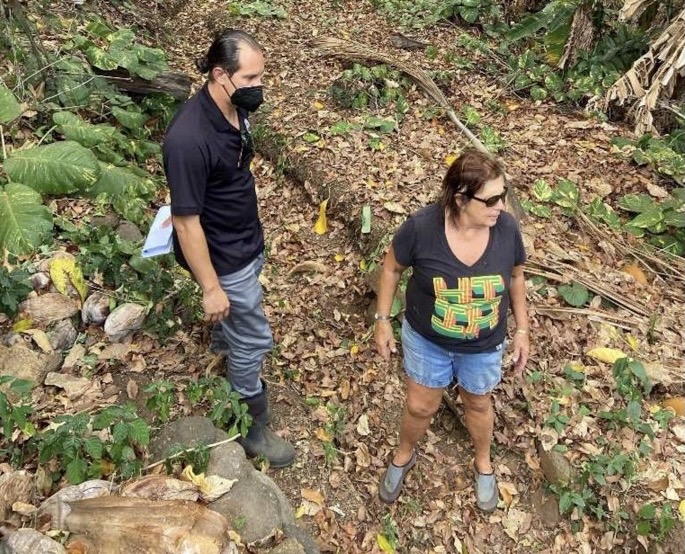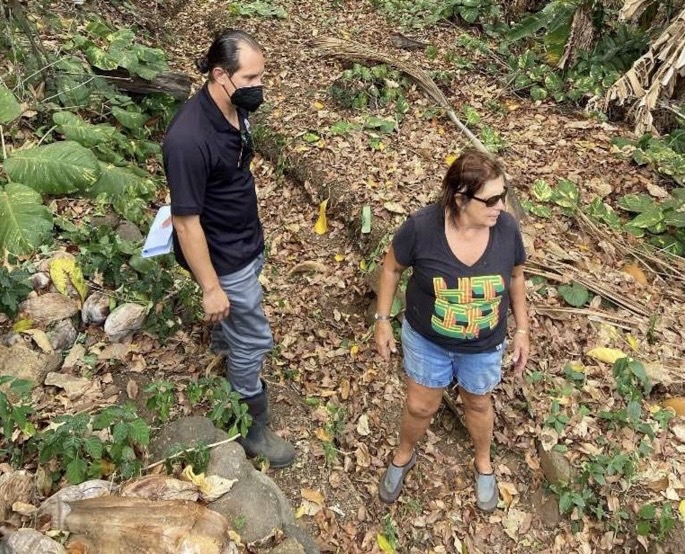By Teresa Dawson
In October, Environment Hawaiʻi reported on a complaint that kuleana tenants with permits to use water from South Waikapū Stream, one of the four streams of Nā Wai ʻEhā, were not receiving what they were due.
They blamed the Wailuku Water Company, LLC, for restricting flows into their ʻauwai and accused the company of selling water to Kumu Farms, which does not have a permit for South Waikapū water, and of allowing former WWC vice president Clayton Suzuki to receive water before them, despite him having a lower priority permit.
On October 19, the Commission on Water Resource Management ordered Wailuku Water Company,and Waikapū Properties, LLC, to stop delivering water to Kumu Farms from Reservoir 1, which receives water from South Wakapū Stream.
Under the state Commission on Water Resource Management decision and order for Nā Wai ʻEhā water use permits, Kumu Farms was to use Waikapū water only until certified organic fields that could be fed by WWCʻs Wahieʻe ditch became available. Once those fields were certified organic, Kumu Farmsʻ water allocation from Waikapū Strem would be reduced to 250 gallons a day for cattle.
In response to the complaint, Kumu Farms informed the commission that water from the stream was only being provided as drinking water to livestock.
“All farming operations have been moved to the makai side of the Waihe‘e Ditch and/or to the makai side of Honoapiilani Highway. Kumu Farms is in the process of finalizing infrastructure that would allow it to transition to pumping water from the Waihe‘e Ditch,” it stated in a September letter to the commission.
Even so, commission staff learned from WWC president Avery Chumbley that his company had continued to provide 75,000 to 125,000 gallons per day of water from Reservoir 1 to Kumu Farms. That was a huge percentage of the 265,188 gallons per day that were supposed to be going to South Waikapū ʻauwai users. Those users included Ho‘okahi Alves, John Minamina Brown Trust/Crystal Smythe, George and Yoneko Higa, Teruo Kamasaki, Clayton Suzuki, and Nadao Makimoto.

Credit: Commission on Water Resource Management
While the actual amount of water being released to the ʻauwai users during a staff site visit exceeded the 265,188 gallons required by the commission’s decision and order, flows dried up about 250 feet beyond the point where water was dropped into a lower ‘auwai segment, well before it could reach the Alves property and Smythe’s upper kalo fields, according to a commission staff report.
While it appeared from the site visit that WWC had not been restricting flows to into the ʻauwai, Hui o Nā Wai ʻEhā president Hōkūao Pellegrino still believed the company played a role in depriving the kuleana users of their water.
He testified to the commission at the October meeting that the Hui wanted it on record that WWC had been selling water to Kumu Farms in apparent violation of the commission’s June 28 decision and order.
“That’s 113 days and over 11 [million gallons], that should’ve been either in the Waikapū Stream or provided to the South Waikapū kuleana farmers. Please commission, when will you bring the hammer down on these deplorable type of acts, corporate water theft and thugs, Avery Chumbley, Kent Lucien and Alan Kubo of Wailuku Water Company?” he asked.
In written testimony, Chumbley did not address the sale of water to Kumu Farms. He did, however, try to correct statements that had been made at the commission’s September meeting.
For instance, he noted that while some had said that a control gate before Reservoir 1 had provided water to the kuleana users but was later cemented shut after being vandalized, that was only partially true. The gate, he said, was an emergency control gate and was never used as a release point into the ʻauwai. It was, however, vandalized to release more water, he added.
ʻAuwai Fix
In September, Pellegrino described his investigations into the improving the leaky, unlined ʻauwai so that it’s more efficient. The cost to install a pipe was nearly $1 million, he found. What’s more, the ʻauwai is on land owned by Waikapū Properties and covered by a perpetual easement held by WWC.
He proposed that the commission require the companies to allow kuleana users to manage the ʻauwai and/or restore the traditional ʻauwai system, which is also on privately owned land.
At the commission meeting in October, Waikapū Properties manager Michael Atherton offered a temporary solution.
“We have an 8-inch main line that we installed 10 years ago for a possible coffee plantation; I can tap into that line and run the pipe over to the kuleana ditch and drop it in right where our property touches the first kuleana property and it would easily be able to reach the South kuleana users and their lo’i,” he said, adding that he could accommodate Suzuki at the same time.
He reported that he had been talking with Chumbley about acquiring the South Waikapū system. “It’s an attempt on Waikapū Properties’ part for a longer-term solution to create a win-win-win for us,” he said.
Earthjustice attorney Isaac Moriwake, who represents the Hui, stressed the need to find a long-term solution.
“We have that short-term temporary solution that’s a band-aid. The pipe is under high pressure and may burst and require repair. It’s only a matter of time,” he said.
He argued that the commission has the authority “to protect the appurtenant rights that includes not just the paper quantity of water, but the ‘auwai, water course and access rights. To say we can only give you a quantity makes no sense legally or practically. It’s like me selling you a house and not the driveway,” he continued.
“We can’t tell the kuleanas to reduce loss and improve efficiency, but not give them the recourse to do that. I want to make it clear that there’s still more steps. We’ll try to work with the parties to restore that traditional ‘auwai and ultimately may have to come to this commission to order that access. We may disagree on the commission’s authority. If so, let’s put that on the table and make it clear where things stand and we can all move forward in figuring out how to protect kuleana rights like they should be, once and for all,” he said.
“The kuleanas didn’t ask to be put on this system, they were told it’s the way it’s going to be because the plantations were irrigating their sugar crops, draining the streams dry,” he said.
He argued that the kuleana users have appurtenant and traditional and customary rights to restore a direct connection to the stream. “The opening of the ‘auwai is on Mr. Chumbley’s land. That traditional ‘auwai could be opened tomorrow but Mr. Chumbley has indicated that he refuses to let that happen,” Moriwake said.
Pellegrino added that he worried that the traditional ʻauwai was in danger of being damaged, having recently witnessed clearing occurring on the south side on Chumbley’s property near the ʻauwai.
“We would like to get this in sooner than later and put in the infrastructure that’s needed and ensure the kuleanas can manage this system independently as their kupuna once did,” he said. He argued that using the traditional ʻauwai would also be more efficient and reduce waste.
He proposed developing an agreement with Chumbley covering who can access his land to clean the ditch. “I understand it’s personal property and at the same time this is a traditional and customary right access issue that needs to be enforced and followed,” Pellegrino said.
Chumbley countered that “this alleged traditional ʻauwai usage was ceased in 1901. … I’ve walked up and down this property from one side to the other and I can assure you that the elevations of the stream are significantly different. The alleged po‘owai [ʻauwai head] off of the stream are different than what some of the documents that we have indicate.”
“The topography of the land today is not conducive to allow for a po‘owai diversion off of this stream in this alleged location; so there’s a tremendous amount of misinformation that’s being represented to you today,” he said.
Commissioner Neil Hannahs asked Chumbley whether he would be able to accommodate the ʻauwai if it could be proven that it was a traditional system.
“I can’t say I would or wouldn’t because I need a better understanding of what the locations and course would be,” Chumbley replied.
He said a process and protocols for interaction could be developed among the commission, the diverters and community that would help address implementation issues regarding the June decision and order.
“We made that suggestion at the August 24th meeting of staff and the [attorney generalʻs office], but nothing has come of it yet,” he said.
Moriwake seemed skeptical, noting that “no one on our side has seen any of that.”
“We’ve done mediations before and with the power differential in terms of people not only refusing to discuss whether an ‘auwai should be open, but even refusing access on the land. Where is this mutual discussion going to take place and how’s that going to happen? The commission needs to not micro-manage and do the job for everyone, but be present at staff level to make sure this moves forward,” he said.
Commissioner Aurora Kagawa-Viviani then suggested that community members should draft their own protocols. “It might be the role of the commission to look at where that overlap is,” she said.


Leave a Reply